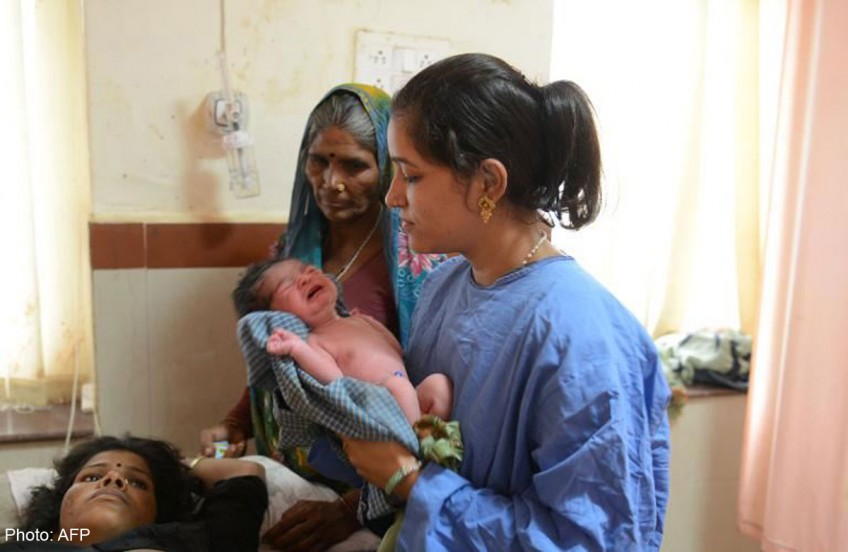Indian infant deaths high but falling steadily


INDIA - Having previously lost two babies to diarrhoea and dysentery, 25-year-old Suman Chandel lies on a bed in a clinic in remote northern India and smiles with relief.
Hours earlier, Chandel gave birth to her fourth child, a seemingly healthy baby boy weighing three kilograms, and is optimistic that this time the chances of survival are good.
"I was very worried beforehand. I was having more and more problems with each delivery, but he seems fine and I'm happy," says Chandel as she tries to breastfeed her newborn wrapped in a blanket.
Married at 15 and pregnant three years later, Chandel's struggles to keep her babies alive are a familiar story for millions of women battling disease, caste discrimination, powerlessness and poverty in rural India.
India has long had a dismal record of deaths from preventable illness; the nation accounts for 29 per cent of global first-day deaths for example -- or 309,000 newborn deaths a year, says non-profit group Save the Children.
But figures from the census office published in October suggests that after 15 years of booming economic growth and explosive modernisation, India may finally be turning the corner.
"There's a long way to go and traditional practices are still there," says Karin Hulshof, regional director for UNICEF, the United Nation's children's fund.
"But there has been great progress, a great call to action, with heavenly investment (at the government and NGO levels)," she tells AFP.
Initiatives have focused on health issues such as encouraging women to give birth in hospitals instead of home, and increasing health centres and immunisation drives.
Education has also been a priority, including on the importance of breastfeeding, improved nutrition and using clean water for hand washing and toilets to prevent episodes of life-threatening diarrhoea.
Paul Vinod, head of paediatrics at one of India's most prestigious teaching hospitals, says the figures speak for themselves - infant mortality rates have dropped from 80 deaths per 1,000 live births in 1990 to 42 deaths in 2012.
Despite the improvements, India still accounts for 22 per cent of the world's deaths of children under five, and more than one quarter of all newborn deaths, the UN, WHO and World Bank estimate in a joint 2013 report.
And public expenditure on health remains woeful, accounting for just 1.2 per cent of gross domestic product, according to Vinod from AIIMS hospital in New Delhi, citing government figures.
"Some developed countries spend eight to ten per cent," he tells AFP. "We should be close to three per cent or five per cent. Anything less than three is poor."
A child's chances of survival are also skewed depending on where a family resides. So the mortality rate in southern Kerala state is 12 per 1,000, the new figures show, but jumps to 56 in Madhya Pradesh -- where Chandel lives.
This postcode lottery is blamed by experts on population density and the priority successive state governments have placed on child health, among other reasons.
Deep cultural issues, including the powerlessness of women and accepted attitudes about their role in society, also remain a huge battle.
"These girls are unable to make independent decisions about their own reproductive choices or fertility," says Anuradha Gupta, a senior official from the Indian health ministry.
"We have a huge battle ahead to change societal attitudes and norms towards adolescents, particularly girls," says Gupta in a November interview with Jhpiego, a nonprofit group attached to Johns Hopkins University.
Pale with anaemia, Radha Bagnele, 20, lies in a bed in Shivpuri District Hospital in Madhya Pradesh and listens to her mother-in-law despair about Bagnele's newborn twin daughters.
"We wanted boys, so we are not happy, we are just okay," says Ramkunar Bagnele sitting on the bed.
"Of course she will keep trying until we get them," she adds.
Married at 13, Radha already has two daughters and worries her husband does not earn enough as a farm labourer to feed and care for their expanding family, who live in a nearby village.
"I'm worried, but we need a boy," she says softly.
Shivpuri hospital, together with UNICEF, have developed a 24/7 call centre and a fleet of 35 ambulances so that women throughout the district can reach a hospital or clinic in time for a safer delivery.
The number of infant deaths has fallen dramatically since its introduction but problems still exist.
In the delivery room, a blanket covers a woman not moving and barely conscious. Her baby died shortly after delivery at home two days earlier, and the woman later collapsed from complications.
"It could be a brain haemorrhage," a doctor says. "She will need to go to Gwalior (a nearby city) we don't have the facilities here."
Down the hall, Sunil Gautam hovers over rake-thin babies in the special newborn care unit also funded by UNICEF.
He points to a boy in an incubator born days earlier weighing 600 grams -- less than a half of the minimum healthy weight of a newborn.
"Eight hundred grams today!" the paediatrician says.
Asked why the 17 babies in the unit were born underweight, premature or sick, he reels off problems that have improved steadily in the five years he has worked there.
"Poverty, illiteracy, nutrition deficiency, early marriage and no spacing between births," he says of the mothers.
"Things are working, are improving," he adds. "But it's slow."